This post is modified from one originally published by the US Department of Energy
The U.S. Department of Energy (DOE) announced $4.3 million in funding for 16 projects in artificial intelligence (AI) research for high energy physics (HEP), including one from UW–Madison physics professor Gary Shiu for his work on applying knowledge gained from string theory research to improving AI techniques.

These awards support the DOE Office of Science initiative in artificial intelligence research to use AI techniques to deliver scientific discoveries that would not otherwise be possible, and to broaden participation in high energy physics research.
“AI and Machine Learning (ML) techniques in high energy physics are vitally important for advancing the field,” said Gina Rameika, DOE Associate Director of Science for High Energy Physics. “These awards represent new opportunities for university researchers that will enable the next discoveries in high energy physics.”
String theory addresses one of the deepest problems of contemporary physics, namely the reconciliation of gravity and quantum theory. It presents an enormously complex system that is well suited as a testbed for advancing AI techniques. The space of string theory solutions is vast, and the associated energy landscape is high-dimensional, computationally complex, and in general non-convex with unknown hidden structures. In recent years, a variety of AI methods have been used to tackle the string landscape.
“Now, the time is ripe for the pendulum to swing back: through studies of the string landscape, novel optimizers as well as AI techniques for discovering hidden structures of complex multi-dimensional data spaces are emerging,” Shiu says. “We propose to export lessons from string theory to advance AI algorithms generally for computationally complex constrained systems.”
Shiu expects that lessons drawn from this work would then be applied generally to AI applications in other large-scale computational problems.